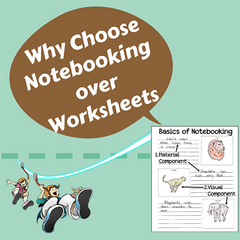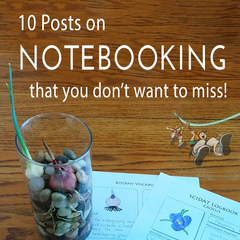
We are talking about writing this month on our podcast and along with that theme, I wanted to share with you all how to record an experiment or scientific demonstration.
Let's dig in...
How to record an experiment
{Update 2020} Listen to this article with additional tips and tricks
in episode 93 of the Tips for Homeschool Science Show.

1. Recording scientific demonstrations during the preschool years
During the preschool years, the students are completingscientific demonstrations. They are watching and playing with science, so the record of what they have learned short and sweet.
Their records of the hands-on aspect of science should contain two sections:
-
Picture — This section will contain a picture or simple drawing from what they saw in the demonstration.
-
Narration — This section will contain one sentence about what they student saw and learned.
At this stage, you will be doing all of the writing. The idea is to create a scrapbook of what they have learned in science that they can enjoy looking over in future years.
2. Recording scientific demonstrations or experiments during the elementary years
During the elementary years, the students are still completing scientific demonstrations but will be moving into do their own experiments. They will begin as observers in the process, so the record of what they have learned will be more simplistic.
Even so, this basic lab report will introduce elementary students to the scientific method. It will serve to prepare them for writing a more detailed report in future years.
Their records of the hands-on aspect of science should include four sections:
-
Our Tools — This section will list the materials used during the demonstration.
-
Our Method — This section will contain the procedure for the demonstration in the students’ words.
-
Our Outcome — This section will contain what they saw and record any data they have collected.
-
Our Insight — The final section will contain a sentence or more detailing what the students have learned. Ideally, this will relate to the science they have studied, but it’s OK at this level for the sentences to be more superficial.
In the beginning, you will record their responses. As they grow and their writing abilities increase, you can have them fill out more and more of the sheet on their own.
3. Recording experiments during middle school and beyond
Middle school students have moved from demonstrations to experiments. These students have shifted from being an observer into performing their laboratory experiments.
Having the students write a record of their experiment at this stage helps them to really grasp the steps of the scientific method.
Their experiment reports should include the following sections:
-
Title — The title is the question the students were attempting to answer or it can explain what they were observing.
-
Hypothesis — In this section, they should share their prediction of the answer to the question posed in the lab. If the lab is an observation, they can share what they think they will see or skip this section of the lab report.
-
Materials — The materials section should contain a list of what the students used to complete the lab.
-
Procedure — In the procedure section, they need to write a step by step account of what was done during the experiment. This should be a summary in their own words so that someone reading it would understand what occurred.
-
Observations & Results — In this section the students should share what they observed during the experiment. They should also include any data they have collected.
-
Conclusion — In the last section the students will write whether their hypothesis was correct. They will also include any additional information they learned from the lab. If their hypothesis was not correct, you will need to discuss why and have them include that on their lab report.
During these years, you will need to discuss the process with the students before they write. This will help you to verify they understand the science behind the experiment. It will also assist the students in formulating their thoughts before they have to write them down.
Additional Resources
To help you get started, here are free templates for each of these reports:
And the following articles will help you dig deeper into some of the concepts suggested in this post:






